
Integrated Digital Enhanced Network (iDEN) is a Motorola land mobile digital data transmission technique for voice and data. Various land mobile radio radio companies (such as Southern Linc) and cellular telephone companies (especially Sprint-Nextel) run regional and nationwide iDEN networks. iDEN voice services are perhaps best known for their push to talk functionality, a direct reflection of the original land mobile business service niche iDEN was designed to fill. Data services can include wireless email and internet access for computers and Blackberry units.
From
a U.S. regulatory perspective iDEN networks are not considered cellular
phone systems and are licensed to operate on 800MHz SMR frequency
allocations (851 - 869 MHz band for
towers; 806 - 824 MHz for mobiles). Thus they do not
enjoy any of the special protections
afforded cellular phone systems transmissions. So while a private
citizen is not permitted to monitor cellular phone traffic it remains
perfectly legal to monitor the exact same type of traffic on an iDEN
network.
Outside the U.S. iDEN
may be known as DIMRS (Digital Integrated
Mobile Radio
Service). Interestingly enough a search using the DIMRS
keyword generally returns information on intimate feminine body
accoutrements (such as here, here,
or even on eBay)... who says engineers don't have a sense of
humor?
From
an orthographic perspective iDEN like eBay is an example of
lowerCamelCase (but not CamelToe).
This page shows some
iDEN data transmission samples collected using ETTUS Research USRP
hardware and GNU Radio software.
Some iDEN Data Transmission Characteristics:
The
transmission format is designed for 25 kHz channel spacing. Data is
transmitted using four 16QAM modulated sub-channels; with each
sub-channel carrying 4000 symbols / second we end up with a total raw
bit rate of 64 kbits/sec. The channel throughput then comes out
to very roughly 3 bits/sec/Hz.
The following shows a
typical iDEN spectrum:

|
Sub-Channel |
Offset relative to carrier center |
|
LO |
- 6750 Hz |
|
LI |
- 2250 Hz |
|
RI |
+ 2250 Hz |
|
RO |
+ 6750 Hz |
Symbol filtering uses the Root
Raised Cosine (RRC) response with roll-off factor α = 0.2. The 4000 symbol /
second
rate is low enough that one does not have to worry about
channel equalization.
iDEN Frame Structure:

Above: Arrangement
of an iDEN frame showing sync, pilot, and data symbols. Pilot
demodulation techniques and slot structures are described in U.S.
Patents 5,519,730; 6,873,614; and 6,909,761.
Note
that sync bursts can also serve as pilots and
therefore an iDEN frame is always terminated with a sync burst (even
if there is no following frame). Also note that split outbound
slot types transmit QPSK data on some pilot symbols; the pilot symbols
can still be used as pilots since the expected magnitude is constant
and the expected phase can be easily derived from the received symbol.
While all sync and pilot symbols have the same (maximum) amplitude they will have varying phases. Essentially these symbols can be viewed as lower order phase modulated symbols:
|
Sub-channel RO |
Sub-channel RI |
Sub-channel LI |
Sub-channel LO |
||||
|
Symbol # |
Phase (°) |
Symbol # |
Phase (°) |
Symbol # |
Phase (°) |
Symbol # |
Phase (°) |
|
0 |
-31 |
0 |
+102 |
0 |
-102 |
0 |
+31 |
|
1 |
-31 |
1 |
-123 |
1 |
+123 |
1 |
+31 |
|
2 |
+149 |
2 |
-168 |
2 |
+168 |
2 |
-149 |
|
5 |
+34 |
9 |
-45 |
9 |
+168 |
5 |
-21 |
|
13 |
-146 |
17 |
+135 |
17 |
-12 |
13 |
+159 |
|
21 |
+34 |
25 |
-45 |
25 |
+168 |
21 |
-21 |
|
29 |
-146 |
33 |
+135 |
33 |
-12 |
29 |
+159 |
|
37 |
+34 |
41 |
-45 |
41 |
+168 |
37 |
-21 |
|
45 |
-146 |
49 |
+135 |
49 |
-12 |
45 |
+159 |
|
53 |
+34 |
57 |
-45 |
57 |
+168 |
53 |
-21 |
|
60 |
-121 |
60 |
-168 |
60 |
+168 |
60 |
+121 |
|
61 |
-121 |
61 |
-33 |
61 |
+33 |
61 |
+121 |
|
62 |
+59 |
62 |
-78 |
62 |
+78 |
62 |
-59 |
Sync
symbols are shown in red, pilot symbols in yellow. Orange symbols
may also be pilots carrying QPSK data.
Symbol locations are
numbered from 0 (first sync
symbol position on left) through 59 (last data symbol position on the
right).
Technically symbols
60, 61, 62 belong to the next
time-slot but they are shown above because they can be used as pilot
references too. Note the phase shifts caused by 60 symbol times
(60 * 0.25ms = 15ms) on the 2250Hz and 6750Hz sub-carrier frequency
offsets come out to plus and minus 90 degrees. When we move to
the next iDEN slot 15ms later symbols 60, 61, and 62 slide to positions
0, 1, and 2 with the phases as shown above.
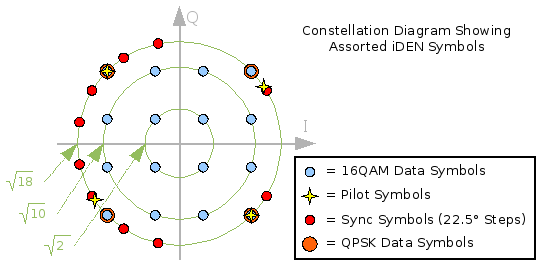
Getting In Sync With The iDEN Frame:

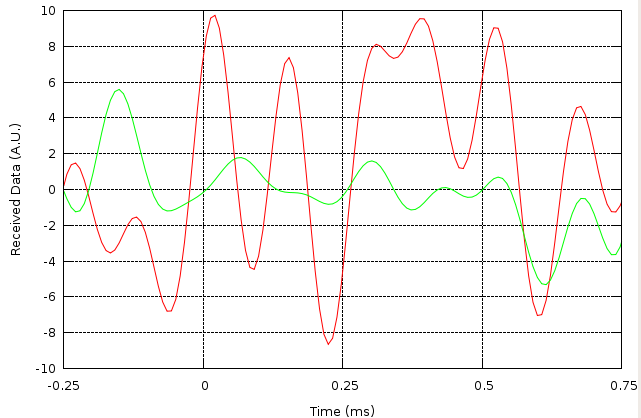
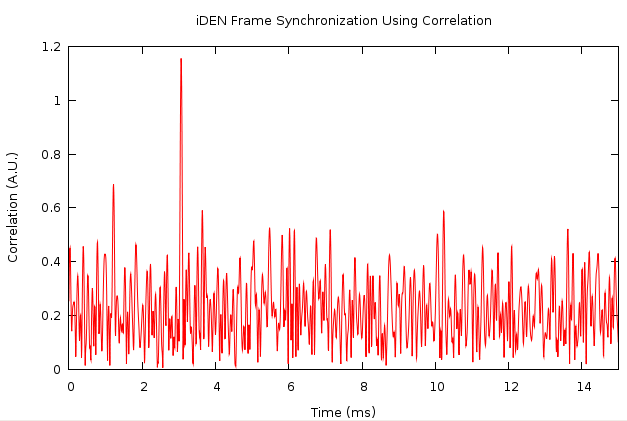
Extracting iDEN Data:

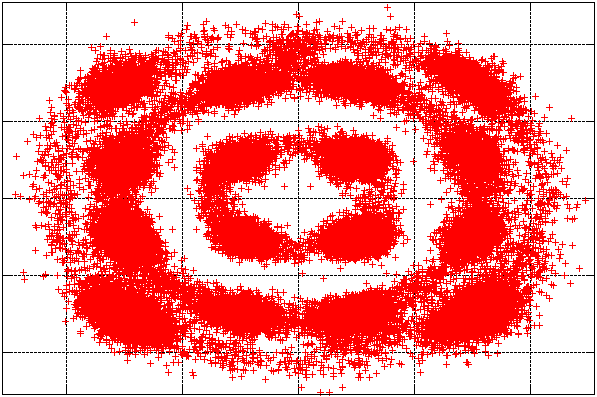
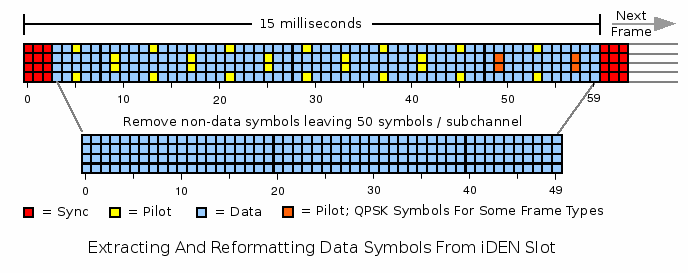
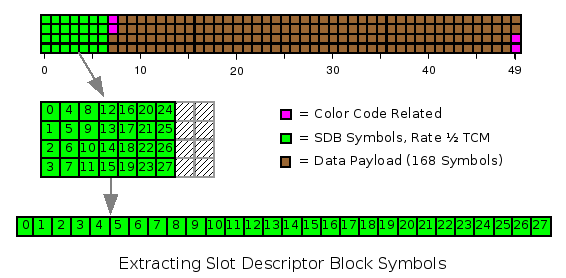
| Rate
½ Dibits |
I |
||||
|---|---|---|---|---|---|
| -3 |
-1 |
+1 |
+3 |
||
| Q |
+3 |
10
01 |
11
01 |
01
01 |
00
01 |
| +1 |
10
00 |
11
00 |
01
00 |
00
00 |
|
| -1 |
10
10 |
11
10 |
01
10 |
00
10 |
|
| -3 |
10
11 |
11
11 |
01
11 |
00
11 |
|
| Current
State |
Input
Bit = 0 |
Input
Bit = 1 |
| 0 |
0 |
1 |
| 1 |
2 |
3 |
| 2 |
4 |
5 |
| 3 |
6 |
7 |
| 4 |
0 |
1 |
| 5 |
2 |
3 |
| 6 |
4 |
5 |
| 7 |
6 |
7 |
| Current
State |
Input
Bit = 0 |
Input
Bit = 1 |
| 0 |
01 |
10 |
| 1 |
00 |
11 |
| 2 |
10 |
01 |
| 3 |
11 |
00 |
| 4 |
10 |
01 |
| 5 |
11 |
00 |
| 6 |
01 |
10 |
| 7 |
00 |
11 |
Ganging iDEN Channels Together:
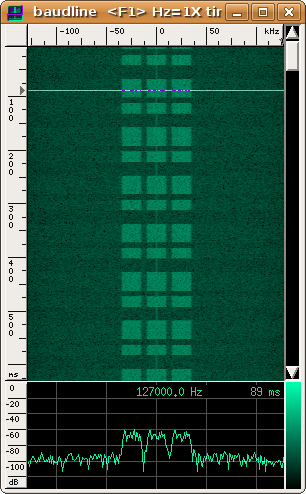
Next Steps: